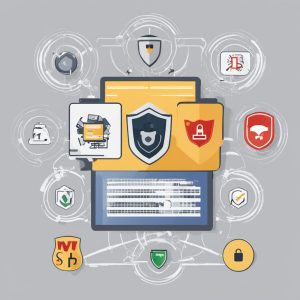
Viruses are small programs that can do a lot of damage to your devices. They, like common viruses that cause diseases, spread from one computer to another and can “infect” files, programs, and sometimes entire operating systems. But how exactly do they do it and what can you do to protect yourself? Let’s take a closer look at this in this article.
How do these “little pests” work ?
Computer viruses work very cunningly. They disguise themselves as ordinary files or programs so that users accidentally launch them. Here’s how they work:
When you open a file or program that contains a virus, the same virus is immediately activated. It begins to perform tasks programmed by its creator. This can be anything from displaying notifications on your screen to deleting important files, stealing data, and even taking control of your computer.
One of the main “abilities” of a virus is its ability to copy itself. It searches for other programs and files on the computer and inserts its code into them. This way, the next time you run these programs or files, the virus will reactivate and continue to spread. They can also use your computer to attack other systems. For example, you can automatically send yourself via email to your friends or colleagues, disguised as a regular email.
Undoubtedly, many people know that some viruses are designed to steal information. They have the ability to record which keys you press on the keyboard, thus collecting your passwords, credit card numbers, and other personal data.
Such mechanisms allow viruses to spread efficiently and invisibly, causing harm to users and entire systems. Therefore, it is very important to be careful what you download and open on your computer.
Now let’s talk about the most important part of this article, namely, how to protect yourself from these pests?
To protect your computer from viruses, you need to use a few simple methods:
First of all, install an anti-virus program. This is the most important step. Antivirus helps to detect and eliminate viruses on your device. It can even block viruses before they do any damage.
Update your antivirus and other programs regularly. Software manufacturers are constantly releasing updates to help protect against new viruses. By installing them, you increase the security of your system.
Be careful with emails and downloads. Do not open emails or attachments from unfamiliar or suspicious sources. Also, avoid downloading programs and files from untrustworthy websites.
Use a firewall (firewall). A firewall helps you control what data enters and leaves your computer via the Internet. It can block potentially harmful access attempts.
Create backups. Regularly backing up important files will help you quickly recover information if a virus does damage your data.
Use accounts with limited rights. Try not to use the administrator account for everyday work. Accounts with limited rights have fewer opportunities to run malware.
Following these simple steps will greatly reduce the risk of computer infection and help keep your data safe.
How did the world’s first computer virus appear?
The world’s first computer virus to gain widespread recognition was called Creeper. Created in 1971 by programmer Robert Thomas, who worked for BBN Technologies. “Creeper” was an experimental software that was created to explore the possibilities of networks. The virus traveled through the ARPANET network, the forerunner of the Internet, and displayed a message: “I’m the creeper, catch me if you can!”
The cripper was not created with the intention of causing any harm, it simply demonstrated the ability to move the program through the network independently. In response to Creeper, another program code called Reaper was created, and this one in turn searched for Creeper on the network and removed it, thus becoming the first antivirus. This event paved the way for the further evolution of computer viruses and the development of anti-virus software.
All of these little pests, as we said, are part of the digital world, which has a lot of interesting things to offer, and here are some interesting short facts about them:
- We’ve already talked about the first computer virus above, but if we’re talking about the very first virus to infect personal computers, it was created in 1982. It was called Elk Cloner and was distributed via floppy disks on Apple II computers. This virus displayed a short poetic message every 50th time the system booted from an infected disk.
- Some viruses are created not for harm, but as a form of digital art or activism. One of them is Bliss, which was written for the Linux operating system. It was never launched without the user’s explicit consent, as its author wanted to show that users should be more careful about what they install.
- The most expensive virus. The damage caused by the MyDoom virus is estimated at approximately $38 billion. It spread via e-mail in 2004 and is considered one of the fastest spreading viruses of all time.
- A virus that “cured” computers. Welchia or Nachi appeared in 2003 to detect and automatically remove the Blaster virus from infected systems. It also downloaded updates from Microsoft to close the vulnerability that Blaster was exploiting. However, Welchia also caused a significant load on network resources.
- Not only computers can become infected with viruses. Mobile phones, smartwatches, and even smart TVs can become victims of virus attacks. This is made possible by the different network connections and operating systems used by these devices.
Given all that we’ve learned about computer viruses, it’s clear that active use of anti-virus software, careful handling of unknown files from the Internet, and all other methods are key to protecting our data and devices. Let’s not forget that technology is constantly evolving, and viruses are evolving with it. Take care of yourself and your data. Being informed means being protected.

